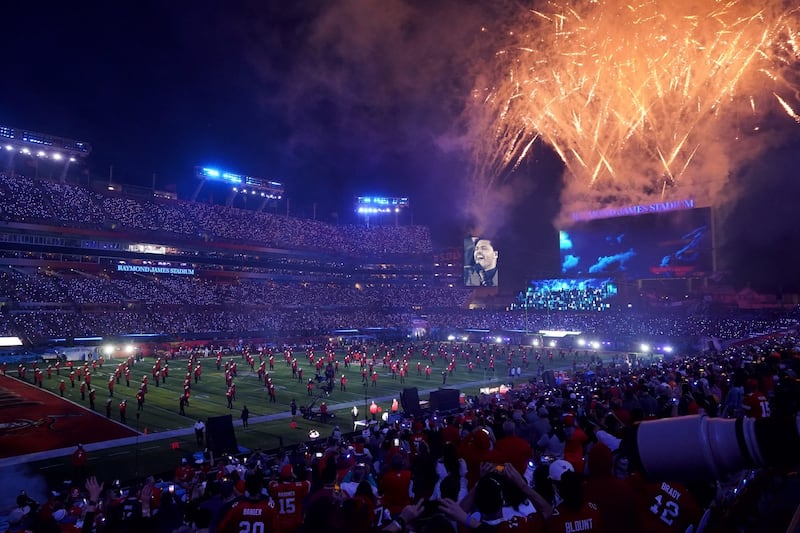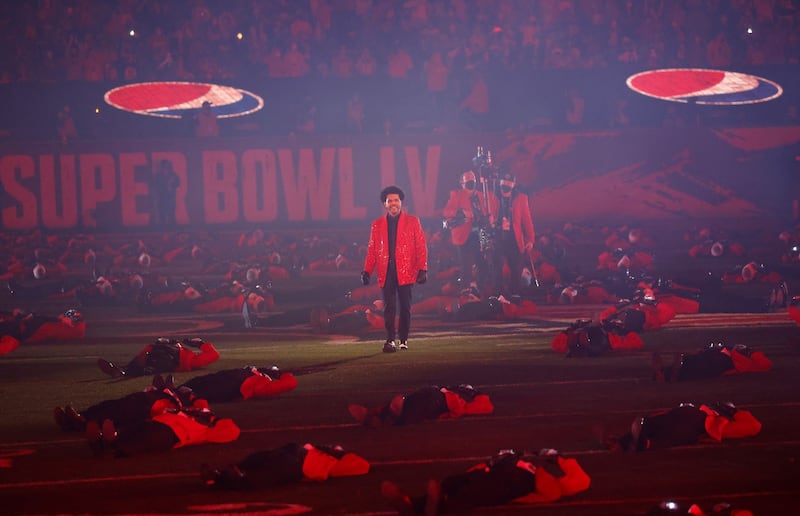For almost all of his decade-long career, the Weeknd has been finding ever more ornate ways to duck the spotlight, becoming immeasurably famous and popular while maintaining a cool, sceptical and effective remove from the harsh, sometimes goofy spotlight of fame.
Out on the stage at the Super Bowl halftime show, though, there isn’t much one can do to hide. It is a locale that flattens nuance, sandpapers intent. It’s live and heavily vetted. For someone whose songs often dive deep into traumatic and provocative subject matter, but gleam so brightly and convincingly that it’s easy to miss the brittle soul within, it is an unlikely, almost vulnerable place to find yourself.
Which probably explains why, at the Super Bowl at Raymond James Stadium in Tampa, Florida, the Weeknd rejigged the terms of the performance. What would ordinarily be a hyper-choreographed spectacle with countless moving parts was instead something more focused and, at times, unnervingly intimate.
In the Weeknd, the NFL opted for one of the few unimpeachable pop stars of the past decade, a consistent hitmaker with an ear for contemporary production
Even though his music tends toward the maximalist, the Weeknd found several ways to make the performance appear small, a kind of secret whispered in front of an audience that tops 100 million.
In a performance clearly designed for at-home consumption, he focused intently on the cameras. Behind him was a band and a choir interspersed among a neon cityscape, and often he was surrounded by dancers – their faces bandaged, in keeping with the fame-sceptic iconography of his recent music videos – but often, the Weeknd stood alone.
His eye contact was intense. When he danced, he mostly did so in isolation. In the midst of a pyrotechnic affair, there he was, keeping his own time.

Glamorous mayhem
That was also partly the result of the unique circumstances of the event this year: a grand-scaled affair reimagined with pandemic restrictions in mind. Rather than the usual stage setup – assembled at midfield, then rapidly disassembled after the show – the Weeknd performed largely from the stands, only descending to the field for the final few minutes of his set.
Wearing a glittery red blazer and spectator shoes with an all-black ensemble, he sometimes appeared like a cabaret mayor, a master of ceremony for a space-age function. He stuck to the biggest of his many big hits. Starboy was vibrant, and The Hills had a majestic sweep.
After The Hills, he pivoted to something more peculiar, walking into an over-lit labyrinth and performing Can’t Feel My Face amid a scrum of face-bandaged look-alikes. The camera was hand-held and unsteady, communicating a glamorous mayhem that this event usually doesn’t dabble in.
Afterward, he tempered the mood with some of his biggest-tent hits: the sunshiny I Feel It Coming, the oversized Save Your Tears and then Earned It, his theatrical ballad from the Fifty Shades of Grey soundtrack.
There could perhaps be no more fitting moment for the Weeknd to be headlining the halftime show: After almost a year of avoiding other people, who better to set the terms of public engagement than pop music’s greatest hermit? That said, it was jarring this week to watch him poke his head out from the shadows, engaging in a terse, not wholly comfortable news conference, and yuk-yuking in a comedy sketch with James Corden.
There are some responsibilities of this level of fame that aren’t negotiable. Asked at the news conference whether he would temper his songs or performance in any way, given how lurid and graphic his recent videos have been, the Weeknd insisted: “We’ll keep it PG for the families, definitely.”
Which is to say, there was no mischief injected onto one of pop music’s grandest, most-viewed and most scrutinized stages – take, for example, the raw carnal provocations of Prince’s 2007 rain-shellacked performance, or the fire-eyed political radicalism of Beyonce’s takeover of Coldplay’s tepid set in 2016, or MIA’s middle finger in 2012.
Mostly, as promised, he kept it PG, though he did toss in a sly grin and a tiny sashay of the hip during I Feel It Coming, and the scattered mayhem during Can’t Feel My Face suggested far more sinister things than could be represented. His recent music videos have focused on the grotesquerie of celebrity worship, but that narrative was nodded to if largely sidelined.

Nod to fans
This is the second halftime show produced in part by Jay-Z’s Roc Nation, in an arrangement struck while the league was trying to address fallout from its handling of Colin Kaepernick’s racial justice protests. In recent years, the NFL has seemingly perpetually been in crisis-response mode. This season was consistently challenged by the effect of the coronavirus.
Before the game, rock-soul singer HER performed America the Beautiful, injecting some Prince-minded guitar filigree. The US national anthem was a duet between phenomenally gifted soul singer Jazmine Sullivan and country stoic Eric Church, wearing a purple moto-esque jacket as if to overemphasize the political and cultural middle ground the performance – sturdy, sometimes impressive – was so clearly striving for.
In the Weeknd, the NFL opted for one of the few unimpeachable pop stars of the past decade, a consistent hitmaker with an ear for contemporary production and an affection for the grandeur and sheen of the biggest 1980s pop. Only during the last couple of minutes, when he finally emerged onto the field, did he acknowledge just how far he had come.
Playing at that moment was a snippet of House of Balloons, the murky title song from his extremely murky debut mixtape, released a decade ago. At that point, the Weeknd was a total cipher, a Toronto miscreant with an ethereal voice and zero interest in sharing himself with the rest of the world.
This nod to his past was quick – a wink for longtime fans – and it gave way to Blinding Lights, his exuberant smash from 2019, which topped the Hot 100 for four weeks. It’s a sterling song that evokes both an idyllic future and triggers aural sense memories of mega-pop’s glory years.
On the field, he was surrounded by hundreds of Weeknd-alike dancers. In the beginning, he moved with them in lockstep. But as the song swelled, and the dancers began to swarm in odd patterns, the Weeknd moved in his own rhythm, holding the camera’s gaze, alone amid the chaos. – New York Times











